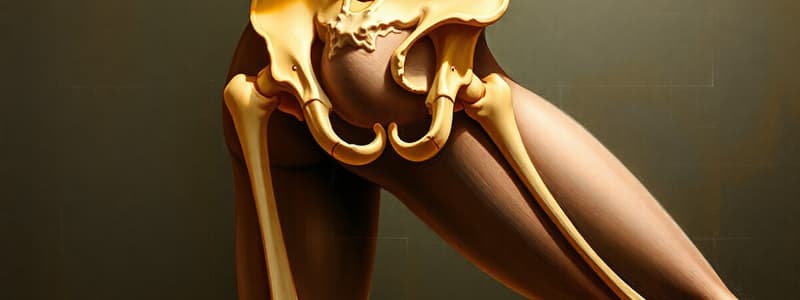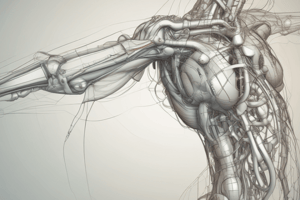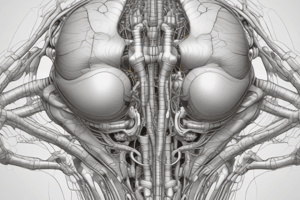Podcast
Questions and Answers
What is the primary function of the pelvic girdle?
What is the primary function of the pelvic girdle?
- To facilitate breathing during physical activity
- To protect the reproductive organs
- To aid in the process of childbirth
- To support the abdomen and link the vertebral column to lower limbs (correct)
Which muscle is NOT part of the pelvic floor?
Which muscle is NOT part of the pelvic floor?
- Pubococcygeus
- Iliococcygeus
- Coccygeus
- Obturator internus (correct)
How do hormones during pregnancy affect pelvic floor muscles?
How do hormones during pregnancy affect pelvic floor muscles?
- They decrease the size of muscle fibers
- They cause muscles to contract involuntarily
- They increase muscle strength
- They can increase ligament laxity, affecting muscle performance (correct)
What occurs to the pelvis during the late swing phase of the gait cycle?
What occurs to the pelvis during the late swing phase of the gait cycle?
What notable change occurs to a woman's center of mass during pregnancy?
What notable change occurs to a woman's center of mass during pregnancy?
During which phase of the gait cycle does the knee reach near full extension until heel off?
During which phase of the gait cycle does the knee reach near full extension until heel off?
Which stage of labor is described as the longest?
Which stage of labor is described as the longest?
What is the primary role of the meniscus in the knee?
What is the primary role of the meniscus in the knee?
At what degree of hip flexion does the gait cycle begin?
At what degree of hip flexion does the gait cycle begin?
Which of the following factors contribute to the stability of the knee joint?
Which of the following factors contribute to the stability of the knee joint?
How does the loading response phase assist in gait?
How does the loading response phase assist in gait?
What is the typical flexion degree of the knee at heel contact?
What is the typical flexion degree of the knee at heel contact?
What occurs to the hip position during the 80% mark of the gait cycle?
What occurs to the hip position during the 80% mark of the gait cycle?
What ligament primarily limits hyperextension of the hip joint?
What ligament primarily limits hyperextension of the hip joint?
Which artery is NOT a contributor to the blood supply of the hip joint?
Which artery is NOT a contributor to the blood supply of the hip joint?
Which of the following myotomes is responsible for hip adduction?
Which of the following myotomes is responsible for hip adduction?
What joints do the medial and lateral menisci primarily relate to?
What joints do the medial and lateral menisci primarily relate to?
What role does the Pubofemoral Ligament play in the hip joint?
What role does the Pubofemoral Ligament play in the hip joint?
Which of the following arteries supplies the muscles of the medial compartment of the thigh?
Which of the following arteries supplies the muscles of the medial compartment of the thigh?
Which movement is associated with the myotome L5?
Which movement is associated with the myotome L5?
What function does the Ischiofemoral Ligament primarily limit?
What function does the Ischiofemoral Ligament primarily limit?
What is the primary reason for the Trendelenburg sign?
What is the primary reason for the Trendelenburg sign?
Which motion describes counternutation at the sacroiliac joint?
Which motion describes counternutation at the sacroiliac joint?
What is the main role of the gluteus medius during gait?
What is the main role of the gluteus medius during gait?
Which ligamentous support is critical for the function of the sacroiliac joint?
Which ligamentous support is critical for the function of the sacroiliac joint?
What muscles are primarily involved in posterior pelvic tilt?
What muscles are primarily involved in posterior pelvic tilt?
Which structure is primarily responsible for smoothness and coordination of lower leg movements?
Which structure is primarily responsible for smoothness and coordination of lower leg movements?
Which nerve innervates the Semitendinosus muscle?
Which nerve innervates the Semitendinosus muscle?
What movement is primarily controlled by the hip flexors during gait?
What movement is primarily controlled by the hip flexors during gait?
Which nerve innervates the gluteus maximus?
Which nerve innervates the gluteus maximus?
Which muscle group is primarily responsible for hip extension during the early stance phase of gait?
Which muscle group is primarily responsible for hip extension during the early stance phase of gait?
During gait, which muscle is responsible for a hip hike on the contralateral side?
During gait, which muscle is responsible for a hip hike on the contralateral side?
Which nerve innervates the Adductor Magnus muscle's hamstring part?
Which nerve innervates the Adductor Magnus muscle's hamstring part?
What role does hip internal rotation (IR) play during gait?
What role does hip internal rotation (IR) play during gait?
Which muscle's innervation is provided by the Obturator nerve?
Which muscle's innervation is provided by the Obturator nerve?
Which muscle is NOT innervated by the Tibial nerve?
Which muscle is NOT innervated by the Tibial nerve?
Which of the following muscles is responsible for eccentric control of hip extension after midstance?
Which of the following muscles is responsible for eccentric control of hip extension after midstance?
What is the primary function of the medial tibial plateau's 'C' shape?
What is the primary function of the medial tibial plateau's 'C' shape?
Which movement corresponds to the anterior roll and posterior glide of the femur on the acetabulum?
Which movement corresponds to the anterior roll and posterior glide of the femur on the acetabulum?
In a closed chain movement, what occurs during hip extension?
In a closed chain movement, what occurs during hip extension?
When the pelvis posteriorly tilts during forward bending and rising, which muscles primarily assist this movement?
When the pelvis posteriorly tilts during forward bending and rising, which muscles primarily assist this movement?
What is the effect of the shape of the lateral tibial plateau on its corresponding meniscus?
What is the effect of the shape of the lateral tibial plateau on its corresponding meniscus?
Which of the following describes closed chain abduction at the hip?
Which of the following describes closed chain abduction at the hip?
What biomechanical movement occurs during hip flexion in an open chain?
What biomechanical movement occurs during hip flexion in an open chain?
What is the consequence of increased concavity of the tibial condyle?
What is the consequence of increased concavity of the tibial condyle?
Flashcards
Pelvic Floor Muscles
Pelvic Floor Muscles
A group of muscles that form a sling-like structure supporting organs in the pelvic cavity. These muscles control bowel and bladder function, sexual function, and support the pelvic organs.
Iliococcygeus
Iliococcygeus
A key pelvic floor muscle that connects the ilium (hip bone) to the coccyx (tailbone). It helps support the pelvic organs and control urination.
Pregnancy & Cardiac Output
Pregnancy & Cardiac Output
During pregnancy, the heart pumps more blood per minute to meet the increased metabolic demands of both the mother and the developing fetus.
Pregnancy & Gait Changes
Pregnancy & Gait Changes
Signup and view all the flashcards
Pelvic Floor during Labor
Pelvic Floor during Labor
Signup and view all the flashcards
Tibial Condyle Concavity
Tibial Condyle Concavity
Signup and view all the flashcards
Proprioception
Proprioception
Signup and view all the flashcards
Tibial Plateau Shape
Tibial Plateau Shape
Signup and view all the flashcards
Hip Joint Movement Planes
Hip Joint Movement Planes
Signup and view all the flashcards
Hip Joint Open Chain
Hip Joint Open Chain
Signup and view all the flashcards
Hip Joint Closed Chain
Hip Joint Closed Chain
Signup and view all the flashcards
Lumbopelvic Rhythm
Lumbopelvic Rhythm
Signup and view all the flashcards
Pelvic Tilt During Stance
Pelvic Tilt During Stance
Signup and view all the flashcards
Lumbopelvic Rhythm - Posterior Tilt
Lumbopelvic Rhythm - Posterior Tilt
Signup and view all the flashcards
Hip Motion During Gait
Hip Motion During Gait
Signup and view all the flashcards
Knee Motion During Stance
Knee Motion During Stance
Signup and view all the flashcards
Knee Stability Drivers
Knee Stability Drivers
Signup and view all the flashcards
Meniscus Function
Meniscus Function
Signup and view all the flashcards
Tibial Plateau
Tibial Plateau
Signup and view all the flashcards
Propulsion & Deceleration in Gait
Propulsion & Deceleration in Gait
Signup and view all the flashcards
Osteo/Arthrokinematics of the Knee
Osteo/Arthrokinematics of the Knee
Signup and view all the flashcards
Hip IR/ER Movement
Hip IR/ER Movement
Signup and view all the flashcards
Hip Joint Blood Supply
Hip Joint Blood Supply
Signup and view all the flashcards
Thigh Blood Supply
Thigh Blood Supply
Signup and view all the flashcards
Iliofemoral Ligament
Iliofemoral Ligament
Signup and view all the flashcards
Pubofemoral Ligament
Pubofemoral Ligament
Signup and view all the flashcards
Ischiofemoral Ligament
Ischiofemoral Ligament
Signup and view all the flashcards
Pes Anserinus
Pes Anserinus
Signup and view all the flashcards
Tibial Tuberosity
Tibial Tuberosity
Signup and view all the flashcards
Sartorius Nerve
Sartorius Nerve
Signup and view all the flashcards
Quadriceps Femoris Nerve
Quadriceps Femoris Nerve
Signup and view all the flashcards
Hamstring Nerve
Hamstring Nerve
Signup and view all the flashcards
Adductor Muscles Nerve
Adductor Muscles Nerve
Signup and view all the flashcards
Tibialis Anterior Nerve
Tibialis Anterior Nerve
Signup and view all the flashcards
Gastrocnemius Nerve
Gastrocnemius Nerve
Signup and view all the flashcards
Hip Extensors Role During Gait
Hip Extensors Role During Gait
Signup and view all the flashcards
Hip Flexors Role During Gait
Hip Flexors Role During Gait
Signup and view all the flashcards
Trendelenburg Sign
Trendelenburg Sign
Signup and view all the flashcards
SI Joint Function
SI Joint Function
Signup and view all the flashcards
SI Joint Nutation
SI Joint Nutation
Signup and view all the flashcards
Couple Forces: Anterior Tilt
Couple Forces: Anterior Tilt
Signup and view all the flashcards
Couple Forces: Posterior Tilt
Couple Forces: Posterior Tilt
Signup and view all the flashcards
Couple Forces: Hip Hike
Couple Forces: Hip Hike
Signup and view all the flashcards
DCML: Sensation
DCML: Sensation
Signup and view all the flashcards
ALS: Sensation
ALS: Sensation
Signup and view all the flashcards
Study Notes
Biomechanics of the Pelvis, Hip, and Knee
- Pelvis: Begins tilting anteriorly during single-limb support, becoming slightly more anterior post-toe-off (second half of stance), and then tilting anterior again in early mid-swing before tilting posteriorly in late swing.
- Hip: 30 degrees of hip flexion at the beginning of the gait cycle; hip extends gradually to ~10 degrees of hip extension at 80% of the gait cycle, with hip flexion occurring at the end of this cycle.
- Knee: Flexed approximately 5 degrees at heel contact, flexing further to 10–15 degrees during loading phase; the knee extends to near full extension during the pre-swing phase before flexing again during the swing phase. In the stance phase the quads are activated eccentrically during loading phase.
- Loading/Unloading in Gait: Simple explanation, not overly analytical—propulsion and deceleration.
- Knee Stability: Factors influencing knee stability include muscles, ligaments, gravity, and joint reaction forces.
- Meniscus Role: Reduces localized pressure/compressive stress on articular surfaces by increasing tibial condyle concavity, improving congruency and joint stability; effects of proprioception, friction, and weight distribution.
- Tibial Plateau Shape: Medial is "C" shaped and larger to accommodate the larger medial meniscus, whereas the lateral tibial plateau is smaller and accommodating the "O" shaped lateral meniscus.
Biomechanics of the Hip
- Hip Osteokinematics: Moves in all three planes, with differences in open-chain (convex femur on concave acetabulum) and closed-chain movements (fixed femur, concave acetabulum moves). Abduction/adduction, internal/external rotation, and flexion/extension all involve different aspects of rolling and gliding.
- Pelvic Rhythm: Pelvis tilts posterior first, rotating over the head of the femur, before the spine extending subsequently. The glutes and hamstrings perform pelvic retrograde movement, pulling the pelvis backward.
- Trendelenburg Sign: A contralateral pelvis drop, indicating damage to the superior gluteal nerve, weakening the gluteus medius and minimus muscles.
The Sacroiliac (SI) Joint
- Function: Transmits body weight from the spine to the lower extremities, with limited available movement.
- Nutation/Counternutation: Anterior sacral-on-iliac, posterior iliac-on-sacral rotation ("simultaneously").
- Ligamentous Support: Iliofemoral, pubofemoral, and ischiofemoral ligaments; these limit hyperextension, abduction, and flexion respectively.
Pelvic Couple Forces
- Couple forces at the pelvis during gait (pelvic anterior/posterior tilts) occur.
Innervation of Lower Extremity Musculature
- Gluteal Region: Gluteus Maximus (inferior gluteal n.), Medius/Minimus (superior gluteal n.). Tensor Fasciae Latae (superior gluteal n.) and piriformis (anterior rami of S1–S2).
- Anterior Thigh: Pectineus (femoral n.), Psoas Major/Minor (anterior rami of L1–L3), Iliacus (femoral n.). Sartorius, Rectus Femoris, Vastus Lateralis/Medialis/Intermedius (femoral n.).
- Posterior Thigh: Semitendinosus/Semimembranosus/Biceps Femoris (tibial division of the sciatic n.).
Blood Supply to the Hip Joint and Thigh
- Hip Joint: Medial/Lateral femoral circumflex arteries (from profunda femoral artery), obturator artery.
- Thigh: Anterior/Posterior compartments (femoral, profunda femoris, perforating, obturator).
Important Landmarks at the Knee
- Pes Anserinus: Tendons of sartorius, gracilis, semitendinosus.
- Tibial Tuberosity: Patellar ligament attachment.
- Tibial Plateau: Medial/Lateral menisci.
- Intercondylar Eminence: Attachment sites for ACL and PCL.
Pelvic Floor
- Pelvic floor muscles include iliococcygeus, pubococcygeus, puborectalis, and coccygeus.
Pelvic Girdle
- Function: Supports abdomen, connects vertebral column to lower limbs, and transmits forces.
Pregnancy and Its Effects
- Increased cardiac output, elevated metabolic demands.
- Increased pulmonary blood flow.
- Reproductive system alterations: Breast tissue, hormones, intra-abdominal pressure changes, and shifting centers of gravity/altered gait.
Studying That Suits You
Use AI to generate personalized quizzes and flashcards to suit your learning preferences.




